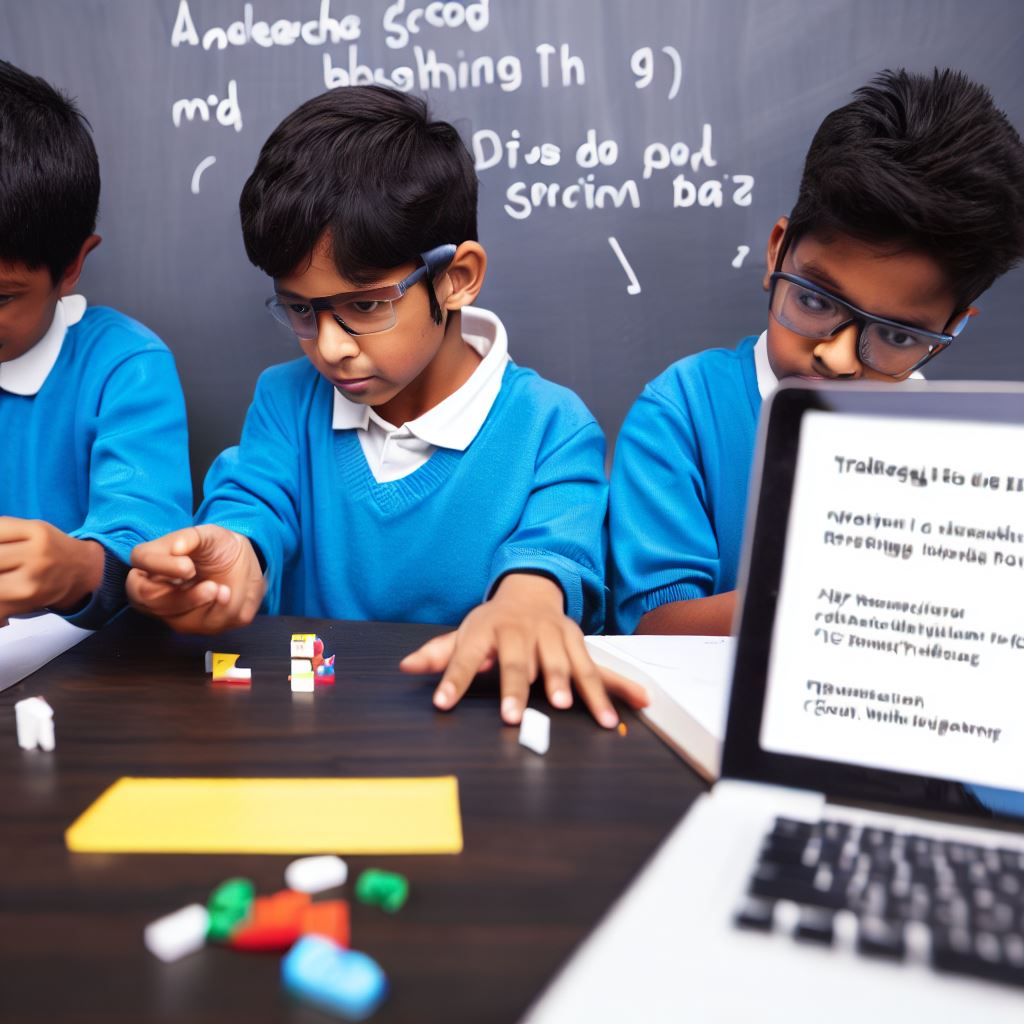Introduction
Coding for kids has become increasingly important in today’s digital age.
The ability to understand and write code not only helps children develop their problem-solving and logical Thinking skills, but also empowers them to become creators of technology rather than just consumers.
With the growing popularity of coding education, there are now numerous resources and platforms available to introduce children to coding at an early age.
These educational tools are designed to make coding fun and engaging, allowing children to learn through interactive games and activities.
By learning to code, kids can gain a solid foundation in computational thinking, which will be valuable in any future career they choose.
Coding also fosters creativity and innovation, as it encourages kids to think outside the box and find unique solutions to problems.
Moreover, coding promotes collaboration and teamwork, as children often work together to tackle coding challenges and create projects.
In an increasingly technology-driven world, coding skills open up countless opportunities for kids, from website and app development to robotics and artificial intelligence.
Teaching kids how to code not only equips them with practical skills, but also prepares them for a future where coding literacy is essential.
Definitions and Fundamentals
What is coding?
Coding is the process of instructing a computer to perform a specific task.
The definition of coding
Coding involves writing a set of instructions in a language that a computer can understand.
Basic concepts of coding
- Sequence: Coding involves writing instructions in a specific order.
- Logic: Coding requires logical thinking and problem-solving skills.
- Conditions: Coding involves using conditional statements to make decisions.
- Loops: Coding allows for repetition of specific instructions.
- Variables: Coding involves using variables to store and manipulate data.
Why should kids learn coding?
Children should learn coding because it fosters problem-solving skills, boosts creativity, and prepares them for the digital future.
Coding cultivates critical thinking, enhances logical reasoning, and empowers kids to create technology.
It equips them with tools to tackle complex challenges and turn ideas into reality. Additionally, coding instills resilience, as debugging and troubleshooting are integral to programming.
Moreover, it promotes collaboration, as coding often involves teamwork and sharing knowledge. In the modern world, coding is a valuable skill in various fields, from science to art.
Tech Consulting Tailored to Your Coding Journey
Get expert guidance in coding with a personalized consultation. Receive unique, actionable insights delivered in 1-3 business days.
Get StartedLearning to code early provides a competitive advantage in the job market. Furthermore, it nurtures computational thinking, essential for understanding how software and hardware interact.
Benefits of coding for kids
- Enhances problem-solving skills: Coding encourages logical thinking and finding solutions to problems.
- Boosts creativity: Coding allows kids to express their ideas and turn them into reality.
- Improves critical thinking: Coding requires kids to analyze and solve complex problems.
- Builds resilience and perseverance: Coding teaches kids to learn from mistakes and keep trying.
- Prepares for the future: Coding skills are in high demand in various industries.
Coding is the process of creating instructions for a computer to follow.
It involves understanding basic concepts and logic.
For kids, learning coding provides numerous benefits such as problem-solving skills, creativity, critical thinking, resilience, and future readiness.
Read: Cracking the Coding Certification: Tips and Tricks
Skills Developed Through Coding
Problem-solving skills
Coding teaches kids to analyze problems and find logical solutions.
Problem-solving skills are a fundamental aspect of coding. When kids write code, they need to identify problems and find logical solutions.
They learn to break down complex tasks into smaller, more manageable steps, which helps them tackle challenges more effectively.
This systematic approach to problem-solving can be applied to various areas of life, helping kids develop critical thinking skills.
Analytical thinking
Analytical thinking is another skill honed through coding. Children learn how to analyze problems, identify patterns, and make connections.
Writing code requires logical reasoning and attention to detail. It enhances their ability to think critically, enabling them to excel in academic subjects and navigate real-life situations.
By writing code, children practice breaking down complex tasks into smaller, manageable steps.
Creativity and Innovation
Coding also nurtures creativity and innovation in children. With coding, kids can create their own digital projects, whether it’s designing a game or building a website.
They learn to think outside the box, experiment with different ideas, and adapt their code to achieve their desired outcome.
Build Your Vision, Perfectly Tailored
Get a custom-built website or application that matches your vision and needs. Stand out from the crowd with a solution designed just for you—professional, scalable, and seamless.
Get StartedThis creative freedom fosters imagination and encourages kids to explore their full potential. Coding encourages kids to think outside the box and come up with unique solutions.
Persistence and Resilience
Persistence and resilience are essential skills developed through coding.
Writing code often involves encountering bugs and errors. Kids learn how to debug their code, a process that requires patience and determination.
They learn to persevere and not give up easily, developing a growth mindset that enables them to overcome obstacles in all aspects of life.
Debugging and troubleshooting common in coding instills perseverance and resilience.
Communication and Collaboration
Communication and collaboration are crucial skills that coding promotes.
Many coding activities involve teamwork, where kids work together to solve problems or create a project.
They learn to express their ideas clearly and listen to others, fostering effective communication. Collaboration promotes teamwork and helps kids understand the value of collective thinking and shared success.
Coding often involves teamwork, fostering effective communication and collaboration skills. Furthermore, Coding is no longer limited to computer science professionals or software engineers.
Coding is a valuable skill for kids that goes beyond computer science knowledge. It teaches problem-solving skills, analytical thinking, creativity, persistence, and teamwork.
Through coding, children develop essential skills that are applicable in various areas of life.
It empowers them to be innovative thinkers, effective problem solvers, and strong communicators.
Encouraging kids to explore the world of coding can open doors to countless opportunities and shape their future success.
Read: Preparing for Your First Coding Certification Exam
Optimize Your Profile, Get Noticed
Make your resume and LinkedIn stand out to employers with a profile that highlights your technical skills and project experience. Elevate your career with a polished and professional presence.
Get NoticedTeaching Coding to Kids
Teaching coding to kids is becoming increasingly important in today’s tech-driven world. While coding may seem complex, it can be introduced to children in a way that is age-appropriate and fun.
Age-appropriate coding activities
- Game-based coding: Introduce coding concepts through interactive games, where kids can learn to code while having fun.
- Scratch: This visual programming language developed by MIT allows kids to create their own stories, animations, and games.
- Robot coding: Engage kids in robotics by teaching them to program robots using coding languages designed for young children.
- Coding puzzles: Encourage critical thinking and problem-solving skills by providing coding puzzles that kids can solve using basic programming concepts.
Programming languages suitable for kids
- Scratch: As mentioned earlier, Scratch is a beginner-friendly programming language that uses visual blocks to create animations and games.
- Python: While Python is a text-based programming language, its simplicity and readability make it suitable for kids as young as 10 years old.
- Blockly: This drag-and-drop programming language is designed for beginners, allowing kids to learn coding concepts without worrying about syntax errors.
- Alice: Alice utilizes a drag-and-drop interface, enabling kids to create 3D animations and interactive games without the need for programming expertise.
Online resources for learning coding
- Code.org: This nonprofit organization offers free coding courses for kids of all ages, with a wide range of interactive activities and tutorials.
- Khan Academy: Known for its extensive educational resources, Khan Academy offers coding lessons that cover various programming languages and concepts.
- Tynker: Tynker provides coding courses with a focus on game development, making it engaging for kids while they learn coding skills.
- Scratch community: The Scratch website features a vibrant community where kids can share their projects, get feedback, and learn from others.
Coding camps and workshops
- Summer coding camps: Many organizations and schools offer coding camps during summer vacations, providing an immersive learning experience for kids.
- After-school coding clubs: These clubs provide a platform for kids to collaborate, learn from each other, and work on coding projects together.
- Coding workshops: Attending coding workshops allows kids to interact with instructors and gain hands-on experience in a structured environment.
- Coding competitions: Participating in coding competitions can motivate kids to improve their skills while engaging in friendly competition with peers.
Teaching coding to kids can be an exciting and enriching experience.
By using age-appropriate coding activities, suitable programming languages, online resources, and attending coding camps or workshops, children can develop valuable coding skills.
As coding continues to play a crucial role in our digital future, empowering kids with coding knowledge is a step towards preparing them for the challenges and opportunities ahead.
Read: Deploying Machine Learning Models in R: A How-to Guide

Integrating Coding in Education
Coding in school curriculum
- Incorporating coding into the curriculum prepares students for the digital age.
- Schools worldwide are recognizing the importance of teaching coding to equip students with essential skills.
- Coding is no longer seen as an optional extracurricular activity but as an integral part of education.
- Including coding in the curriculum helps students develop computational thinking and problem-solving skills.
- Coding enhances creativity and fosters innovation among students, encouraging them to think outside the box.
Coding as a cross-curricular tool
- Coding is not limited to computer science; it can be integrated into various subjects.
- Math teachers can use coding to make abstract concepts more tangible and engaging for students.
- Science teachers can incorporate coding to simulate experiments and analyze data.
- Language arts teachers can incorporate coding through storytelling and interactive digital projects.
- History teachers can use coding to create simulations and explore historical events in an interactive way.
Challenges and benefits of integrating coding
- One challenge is the lack of trained educators who are proficient in coding.
- Schools need to invest in professional development programs to train teachers in coding.
- Another challenge is the limited availability of resources and technology infrastructure.
- Developing coding curriculum requires careful planning and alignment with learning objectives.
- Despite these challenges, the benefits of integrating coding are immense.
- Students become digital creators instead of just consumers, empowering them in today’s technology-driven world.
- Coding fosters critical thinking, collaboration, and communication skills among students.
- It encourages students to persevere and develop a growth mindset when facing coding challenges.
- Integrating coding prepares students for future careers in fields such as software development and data analysis.
- It also promotes gender equality in the tech industry by encouraging girls to pursue coding.
Integrating coding into education is crucial to prepare students for the digital era.
It should be included in the school curriculum and seen as a cross-curricular tool.
Despite challenges like lack of trained educators and limited resources, the benefits of coding are undeniable. It fosters essential skills, empowers students, and prepares them for future careers.
By embracing coding, schools can provide students with the necessary tools to thrive in an increasingly technology-driven world.
Read: Coding Certifications for Kids: A Comprehensive Review
Coding Tools and Platforms for Kids
Coding has become an essential skill for kids in today’s digital era.
It empowers them to understand and create technology, fostering problem-solving and critical thinking abilities.
Fortunately, there are various coding tools and platforms designed specifically for kids to learn and practice coding.
These tools provide a user-friendly and interactive environment, making coding accessible and engaging for children.
Scratch
Developed by MIT, Scratch is a visual programming language designed for kids aged 8 to 16.
It utilizes a block-based coding system, where kids can create interactive stories, games, and animations by dragging and dropping blocks of code.
Scratch encourages creativity and collaboration through its online community where kids can share and remix each other’s projects.
Blockly
Blockly is another visual programming language that uses blocks to teach kids coding concepts.
It offers a simple and intuitive interface, enabling kids to build their own programs by connecting blocks together.
Blockly supports various platforms, including web browsers, Android, iOS, and even physical devices like LEGO Mindstorms.
With Blockly, kids can develop logical thinking skills and learn the basics of coding through a hands-on approach.
Code.org’s Hour of Code
Hour of Code is an initiative by Code.org that aims to introduce coding to students worldwide in just one hour.
It provides a collection of interactive coding tutorials featuring popular characters like Minecraft, Star Wars, and Frozen.
Hour of Code tutorials are designed to be self-guided and self-paced, allowing kids to learn at their own comfort level.
This platform is great for introducing coding to kids as a fun and accessible activity.
Tynker
Tynker is a comprehensive coding platform that offers various resources to teach kids programming.
It provides step-by-step coding lessons, interactive puzzles, and creative projects to engage young learners.
Tynker supports block-based coding as well as text-based coding using languages like Python and JavaScript.
It also enables kids to create their own games and apps, giving them a sense of accomplishment and ownership over their projects.
Swift Playgrounds
The Swift Playgrounds is an app developed by Apple to introduce kids to the Swift programming language.
Also, Swift is used to build apps for iOS devices, making Swift Playgrounds an excellent choice for kids interested in app development.
The app offers a range of interactive coding challenges and a 3D world where kids can apply their coding skills to solve puzzles and complete missions.
Swift Playgrounds provides a nurturing environment for aspiring young developers.
These coding tools and platforms provide a stepping stone for kids to enter the world of coding.
They offer engaging and interactive learning experiences that build a solid foundation for future programming skills.
Whether it’s creating games, animations, or apps, these tools empower kids to express their creativity and problem-solving abilities.
Introducing coding to kids at an early age can open doors to countless opportunities and prepare them for the digital future.
Start exploring these coding platforms and unleash your child’s potential in the world of coding!
Conclusion
Coding for kids is extremely important in today’s digital age.
It not only helps children develop problem-solving and critical thinking skills, but also prepares them for future careers in technology.
Throughout this blog section we have discussed the various benefits and advantages of coding for kids.
From enhancing creativity to fostering collaboration and teamwork, coding has a significant impact on a child’s overall development.
Parents and educators play a crucial role in introducing coding to children.
By encouraging and providing opportunities for them to explore coding, they can help unlock a world of possibilities for their future.
It is essential for parents and educators to understand that coding is not just about programming.
It is about empowering children with the skills to navigate and shape the digital world around them.
By introducing coding at an early age, children can gain a competitive edge in the job market and become creators rather than just consumers of technology.
Therefore, it is crucial for parents and educators to embrace coding and incorporate it into children’s lives.
Whether it is through coding clubs, online resources, or dedicated coding classes, there are numerous avenues available to foster a love for coding in children.
Coding for kids is a valuable skill that equips them with the tools needed to thrive in a technology-driven world.
Let’s empower our children to code and watch them excel in the future!




